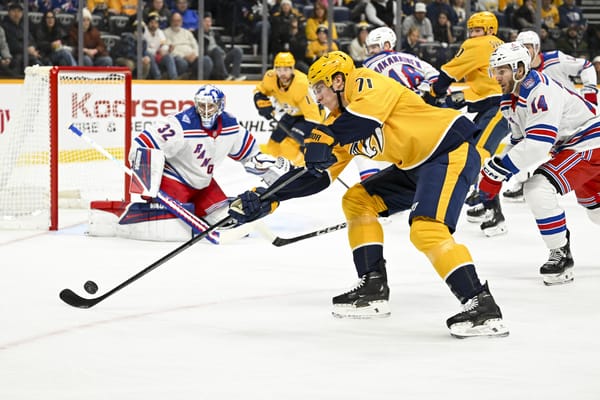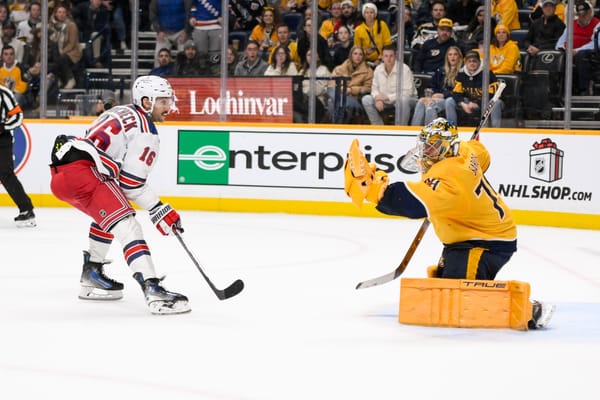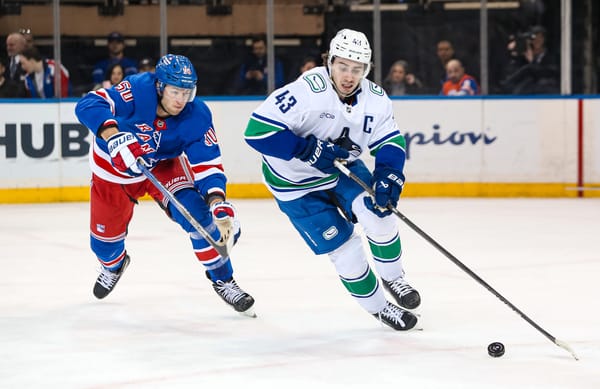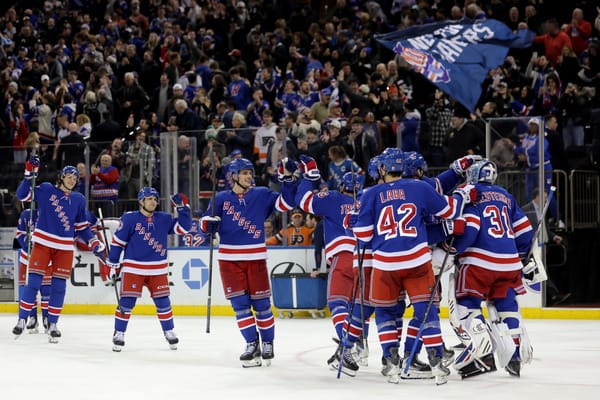Brady Skjei’s Game Has Improved Since Adam McQuaid Was Traded
After what was considered a down sophomore season, much of the resurgence of Brady Skjei has been credited to the stabilizing force on his right side — Adam McQuaid. While appreciated for his heart and soul mentality and experience, the right-handed defender known for his defensive abilities may have been applauded too much for his influence on Skjei and balancing out the pair they formed for much of the season.
Since McQuaid was traded on deadline day, Skjei’s experimented with a few partners over the last few games. Although he hasn’t exactly had consistency in who he’s played with, he’s been consistently solid despite being without his mainstay partner.
McQuaid, on the other hand, was made a healthy scratch with the Columbus Blue Jackets after just one week with the team, despite holding down a regular spot with the New York Rangers.
Tortorella on scratching McQuaid for Kukan:
— Brian Hedger (@BrianHedger) March 4, 2019
"I have to make decisions on who I think is our best six, too, and right now 'Quaider' isn’t that. Little concerned about the speed of the game with him and so we went back to the other guys."#CBJ
NYR gets 4th rd and 7th rd pick
— Sean Tierney (@ChartingHockey) February 25, 2019
CBJ gets McQuaid
NYR's doing their rebuild right, collecting lots of picks. In this case, they rid themselves of a salary and a negative impact player too.
Advantage: NYR
Trade machine: https://t.co/Uv559Sw0Mp pic.twitter.com/ZI0EEEMKJ7
McQuaid was stapled to the side of Skjei, and was described by head coach David Quinn in a positive light, or what I surmised to either be “good public relations for an impending UFA they wanted to move at the deadline,” or a questionable player evaluation.
He certainly gives us that defensive presence, and one of the things I think that’s underrated about Adam is he can make an outlet pass. And I think just having that security blanket, so to speak, as a partner has allowed Brady to play a better game.” - Quinn on Brady and McQuaid
— New York Rangers (@NYRangers) January 17, 2019
I wrote about why I felt the talk was nonsense here, and feel free to give it another read if you want.
Related
Is Adam McQuaid Actually Bringing out the Best In Brady Skjei?
In the 56 games prior to McQuaid’s departure, Skjei had three goals and 11 assists while skating 21:04. During that same period he ranked fifth in CF% and CF% Rel at 44.45 and -2.68 respectively. Of the 987:51 logged during that period 436:57 was spent with McQuaid in which the duo had a collective CF% of 43.39 and a CF% Rel of -4.31. Away for McQuaid, Skjei’s CF% Rel was -1.48. The TL/DR of this is that the numbers weren’t great — even if you remove McQuaid from the Skjei equation — but McQuaid wasn’t doing him any favors either. Now that McQuaid is in Columbus, how has Skjei played in his absence?
While the sample size is understandably small, Skjei has looked pretty solid since he’s been unchained from McQuaid. The 24 year old has scored three goals and added two helpers for five points while skating 20:36 a night in seven games
From an underlying numbers perspective, Skjei is the only rear guard with a positive shot share percentage (Corsi) with a rate of 50.84%. He’s also second in GF% at 64.29 — newcomer Libor Hajek sits at 66.67% through an extra small sample of four games played — and first among the D in scoring chances share at 53.98%.
These numbers are good, but it would be foolish to ignore that he’s on a bit of PDO bender (106.3) which is a combination of an on-ice shooting percentage of 13.43 and save percentage of 92.8.
The numbers get more interesting when looking at who Skjei has played with, and more importantly the impact he’s had on his partner.
His most frequent partner since McQuaid was pulled from the lineup has been Neal Pionk, and collectively the unit has been propped up by Skjei. The tandem possess the puck at a decent rate of 51 percent (+5.16 Rel), but Pionk has fallen flat without Skjei (-3.05).
Skjei, as referenced earlier, has held his own and his overall numbers would probably be better if not for his next partner.
The Brendan Smith situation has been interesting to say the least, as he’s played as a fourth-line winger while also getting some shifts as a defender on the penalty kill. Overall the time him and Skjei have shared together, particularly in the few games since the deadline, hasn’t been pretty. It speaks volumes that the pair has less than a 38 percent Corsi, and that Skjei’s improves by more than 11 percent when Smith is on the bench. I can understand why the pairing has continued, and I do wonder what an extended sample uninterrupted — similar to that of the 2016-17 playoffs — would do for the pair. If they don’t get the opportunity though, especially considering these results, it would be understandable.
Skjei and Shattenkirk is what I’d describe as a fine pairing. It has been average — sans the PDO of 107.1 driven by a shooting percentage of 17.65 and a lackluster save percentage of 89.47%.
The last pairing involves Tony DeAngelo. Overall the numbers for this pair speak for themselves. When they have been on the ice together they’ve dominated possession and that is a byproduct of DeAngelo being a solid skater and puck distributor. This could be an interesting pair going forward, as it’s not the first time they’ve skated together after spending some time together earlier this season, last season, and at the World Junior Championship. If Marc Staal is bought out or somehow isn’t a part of the team in the near future, or there’s a better partner for the veteran, then this may be an option to further explore. Since DeAngelo and Staal have had solid results together though, especially compared to Staal’s other partners, they may stay together in an effort to balance the blue line for the time being.
If this is the start of things turning around for Skjei, that would be great news for the New York Rangers. They’ve invested a lot in him — $31.5 million over six years to be exact — and they did so because they believe in him. Opinions were mixed over his mega deal, but there were certainly sensible reasons why the Rangers took the plunge.
Related
Breaking Down Brady Skjei’s Contract Extension
I think this #taek wasn’t as wild as my Zibanejad one from earlier this season — which I revisited here — but I am putting it out in the view again for the sake of transparency. So in the event things go bust, well...
In all seriousness, there’s more than enough time for Skjei to develop into the defender the Rangers are paying him to be. His season, despite what the coaches may believe, was negatively impacted by playing with too one-dimensional of a partner in McQuaid for as long as he did this season, and in many ways it was like his two prior seasons. In his first season he had the misfortune of playing with Kevin Klein for 479 minutes, even though the tandem of Skjei and Adam Clendening was a banger of a third pair for over 200 minutes.
Last season he spent a majority of his time with Shattenkirk, and we then learned that No. 22 spent a good chunk of the season playing hurt. What followed was him being deployed with six different partners for at least 100 minutes, a stint with Steven Kampfer for 92 minutes, and then 81 minutes with Nick Holden.
This sounds like making excuses for Skjei, and to that I will refer to what I wrote last summer.
Ultimately the great players are able to persevere despite the circumstances they are placed in, but that’s asking a lot for a player in their second pro season. There’s a chance he and Shattenkirk could have worked out had Shattenkirk remained healthy, but we will never know. What we do know is that a developing player was saddled with a gaggle of pretty bad players and was asked to make the most of it.
Skjei has 232 games under his belt, and will soon be finishing his third full season, but none have them have been normal ones. First season he was adjusting to the NHL, his second year he played with multiple partners on a team that quit at the end, and this year the defense isn’t spectacular as a whole while David Quinn is implementing his system. To this point he’s posted a stat line of 15-68-83 which equates to a P/GP of 0.36.
Next season is going to be a huge one for him in terms of evaluation, as he will be 25 with two full seasons remaining until his 10-team no trade list goes into effect. The Rangers have to address the defense moving forward and it’ll be interesting to see what role Skjei plays in that. Giving him a competent partner to spend the entire season with would be a nice start, but ultimately he needs to hold up his end of the bargain. There’s always the chance Skjei could be moved out if the front office wants to rebuild the defense from scratch, but I would think he gets another season to prove himself first.
If anything, I think it is fair to say that initial expectations on Skjei were high, and it was hard to ignore the comparisons to Ryan McDonagh made by Gordie Clark. At this point, it looks like Skjei is unlikely to become the player that McDonagh was, but that doesn’t mean he can’t be a solid defender worth his contract.
It has been just seven games — and a lot can change the rest of the way — but it is once again clear that McQuaid was holding Skjei back instead of saving him. But now that the deadline has come and gone, it should be exciting for fans to see what he’s able to accomplish the rest of the way. He certainly has the tools to be a successful defender, and maybe he will be the next Ranger to figure it out and move forward under Quinn.
Stats via Natural Stat Trick unless otherwise noted.





